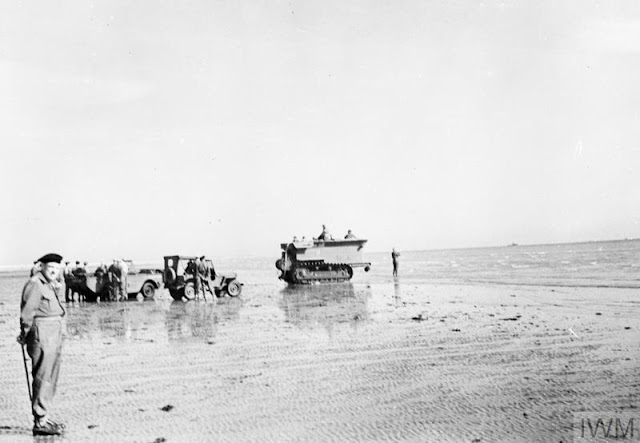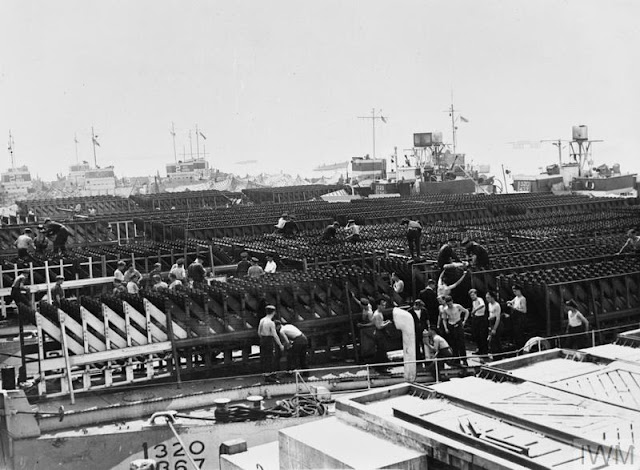Invasion Craft During a Training Exercise.
A23667. Vehicle disembarking from a "Rhino" Ferry which has transferred
them from a Landing Ship (Tank) to the beach. Photo Credit - Part of
Admiralty Official Collection, Imperial War Museum (IWM)
Introduction:
As World War II continued Combined Operation Centres or camps began to dot the shoreline of the United Kingdom and troops from Allied countries trained on more varied and larger landing crafts.
Thousands of men would have surely remembered their first practise operations in southern England or north west Scotland because embarking on, e.g., an assault landing craft, travelling to a new location and disembarking onto a shingle beach - as a lead up to a D-Day (Disembarkation Day) - was no picnic on rough seas or against unexpected opposition.
Canadians in Combined Operations, initially acquainted with ALCs and LCMs in Scotland before the Dieppe raid and invasion of N. Africa in 1942, and later introduced to other types of craft - including LCI(L)s - in, e.g., the English Channel in preparation for D-Days in Sicily, Italy and France (and more), have stories about sea conditions, how troops fared on board unfamiliar crafts, and other matters about training.
About training in 1942 at HMS Quebec, Inveraray, my father writes:
We did much running up on beaches so soldiers could disembark and re-embark, always watching the tide if it was flowing in or going out. You could be easily left high and dry, or broach too, if you weren’t constantly alert.
We took long trips at night in close single formation, like ducks closed up close, because all you could see was the florescent waters churned up by propellors of an ALC or LCM (landing craft mechanized) ahead. (Page 13, "DAD, WELL DONE")
About training near Irvine, Scotland (while at Camp Auchengate, near RAF Dundonald) he writes two slightly different accounts of the same training exercise (Schuyt I, 1942):
Sometimes at Irvine I acted as seaman along with Gash Bailey under a Coxswain named Owen... One night we had an exercise landing, complete with soldiers against shore defences. Also, we had a stoker, Lank, who was below decks. My, it was rough and cold. The stoker took a pail to vomit in and Gash and I lashed ourselves down on ALC cowling.
We had an officer named Jake Koyl who was later to become our commander after Lieut. McRae was captured at Dieppe. During the exercise the soldiers became sick, oh so terribly sick. (Page 17, Ibid)
At the night exercise the time of arrival was midnight. The crew was Koyl, Art Bailey, Stoker Lank and his pail (Willard Lank was always chewing kelp), and myself, with a full complement of English soldiers.
About training near Irvine, Scotland (while at Camp Auchengate, near RAF Dundonald) he writes two slightly different accounts of the same training exercise (Schuyt I, 1942):
Sometimes at Irvine I acted as seaman along with Gash Bailey under a Coxswain named Owen... One night we had an exercise landing, complete with soldiers against shore defences. Also, we had a stoker, Lank, who was below decks. My, it was rough and cold. The stoker took a pail to vomit in and Gash and I lashed ourselves down on ALC cowling.
We had an officer named Jake Koyl who was later to become our commander after Lieut. McRae was captured at Dieppe. During the exercise the soldiers became sick, oh so terribly sick. (Page 17, Ibid)
At the night exercise the time of arrival was midnight. The crew was Koyl, Art Bailey, Stoker Lank and his pail (Willard Lank was always chewing kelp), and myself, with a full complement of English soldiers.
Believe me, these fellows were sick soldiers. Bailey and I lashed ourselves down as best we could and emptied the helmets as the soldiers handed them up. Destination or landing, I don’t remember. Troon (Scotland)? (Page 51, Ibid)
For more information about Landing Crafts and Operation Fabius (training exercise in English Channel), please visit Search Our Collections at Imperial War Museum:
For more information about Landing Crafts and Operation Fabius (training exercise in English Channel), please visit Search Our Collections at Imperial War Museum:
a beach, showing the necessity of waterproofing the engine. (IWM)
A23669. LCT beached with its bow doors open and loaded with tanks
on the south coast during exercises for the Normandy landings.
south coast during exercises for the Normandy landings. IWM.
A23672. Sherman tank embarking backwards in to an LCT at the Hard,
Portsmouth during exercises for the Normandy landings. (IWM).
A23673. Vehicle embarking backwards in to an LCT at the Hard on the
south coast during exercises for the Normandy landings.
RN official photographer, Imperial War Museum
Heading with following photographs - Invasion craft, May 1944, south coast, during exercises of craft and men taking part in the great assault.
A23675. Unloading stores from a Landing Barge (Vehicle) in to trucks
upon the beach. Part of Admiralty Official Collection, IWM
Nine German E-boats stationed at Cherbourg were apparently aware of the operation and dashed in between the patrol ships to attack our convoy. They selected a group of eight LSTs as targets and successfully launched torpedoes against three of them. LST-507 and LST-531 were sunk. LST-289 while firing at an E-boat was hit by a torpedo and despite suffering a number of casualties, managed to beach successfully.
This saved the remaining troops and crew as well the military equipment but the LST was too damaged to be available for the Normandy invasion. The remaining LSTs fired vigorously at the E-boats without success. At this time the LSTs were only equipped with 20 and 40 mm anti-aircraft weapons. The single 3 inch cannon which was part of the original ordinance had been removed and replaced with a dual 40 mm Bofors battery.
In this exercise 197 Naval and 441 Army personnel lost their lives. It turned out that this was greater than the actual losses on D-day at Utah beach. It was reported that many lives were lost because both soldiers and sailors were reluctant to abandon ship. When we returned to our berth in the Salcombe estuary we received orders to have an abandon ship drill. (As found at LandingShip.com)
approach the beach to strand shortly after high water.
Part of Admiralty Official Collection. IWM.
A23677. Wading bulldozer D8 for clearing beach obstacles and for pushing
off stranded landing craft. Part of Admiralty Official Collection. IWM.
A23728. Fusing the rockets being loaded aboard a Landing Craft (Rocket).
Photo Credit - Lt. J.A. Hampton, RN official photographer, IWM.
A23729. General view of landing craft support (rocket) being loaded with
projectiles at Southampton. Lt. J.A. Hampton, RN photographer, IWM.
A23730. A large group of LCTs (Landing Craft Tank) moored along the quay-
side at Southampton, 1944. Lt. J.A. Hampton, RN photographer, IWM.
side at Southampton, 1944. Lt. J.A. Hampton, RN photographer. IWM.
Please link to Photographs: Training on Landing Crafts (7).
Unattributed Photos GH.













No comments:
Post a Comment